| Computing |
Exercise and fitness can make a big difference to back pain.
Unfortunately back pain tends to deter exercise, but medical opinion is now firmly in favour of movement and exercise, as part of back care.
Top Tips:
|
DO |
DON'T |
The best type and intensity of exercise is different according to your condition, your fitness and the state of your back. You need some exercise, but not too much. That's why you may be given conflicting advice by different experts. If that happens, learn the broad principles and then go your own way - it's your body and only you can feel it. The key is to start gently, choose your sports carefully, and gradually develop into a more strenuous regime. Getting fit is a stress/recovery process, while most bad backs result from too much or too prolonged stress, with incomplete recovery. Your exercise "sweet spot" will be unique to you, and will change as you get fitter and your back heals. |
|
Find something that you enjoy and that can be easily incorporated into your daily life. This can be easy to achieve, for instance: if you normally get the bus to work, try getting an earlier one and getting off a few stops earlier. Park your car further away from your destination and walk. When going out to lunch, try to find a restaurant that is within walking distance. Walk up or down stairs instead of taking the lift.
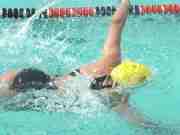 Swimming
is a good exercise for back sufferers since it strengthens
the muscles while your body is supported by water.
Swimming
is a good exercise for back sufferers since it strengthens
the muscles while your body is supported by water.
Swim crawl with side breathing rather than breaststroke, because breaststroke can put strains on the neck and back (and on your knees too). Aqua-aerobics is probably an especially good start. Your local leisure or community centre probably runs exercise and swimming classes.
Here are some starter exercises to strengthen your muscles - they are too boring to keep up for long, but they enable you to exert close control over back stress and pain, while you build up some initial muscle tone.
Don't persevere with anything that makes your back pain worse.
Do a little every day, not a lot every few days.
|
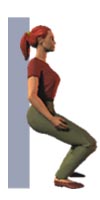 |
||||
Lie on your stomach. Tighten the muscles in one leg and raise it from the floor. Hold your leg up for a count of 10 and return it to the floor. Do the same with the other leg. Repeat five times with each leg. |
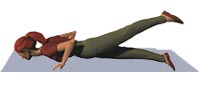 |
||||
Lie on your back with your arms at your sides. Lift one leg off the floor. Hold your leg up for a count of 10 and return it to the floor. Do the same with the other leg. Repeat five times with each leg. If that is too difficult, keep one knee bent and the foot flat on the ground while raising the leg. |
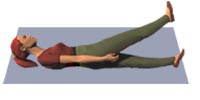 |
||||
Stand behind a chair with your hands on the back of the chair. Lift one leg back and up while keeping the knee straight. Return slowly. Raise other leg and return. Repeat five times with each leg. |
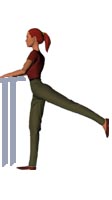 |
||||
Exercises to help flexibility in your back
Lie on your back with your knees bent and feet flat on your bed or floor. Raise your knees toward your chest. Place both hands under your knees and gently pull your knees as close to your chest as possible. Do not raise your head. Do not straighten your legs as you lower them. Start with five repetitions, several times a day. |
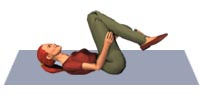 |
||||
Stand with your feet slightly apart. Place your hands in the small of your back. Keep your knees straight. Bend backwards at the waist as far as is comfortable, and hold the position for one or two seconds. |
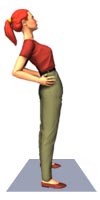 |
||||
Lie on back with both knees bent. Bring one knee to chest, grasp knee with both hands, pull as close to the chest as you can. Lower knee back to starting position. Repeat with other leg. |
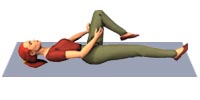 |
||||
Lie on stomach with palms by shoulders as if to do a push-up. Slowly push shoulders up while keeping pelvis in contact with the surface; back and buttocks relaxed. Slowly lower shoulders. Move cautiously for several repetitions and then move more vigorously as tolerated. Lock elbows, exhale, and let the lower back sag while sustaining the up position for several seconds during last few repetitions. |
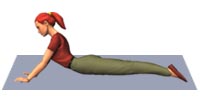 |
||||
Why exercise is good for your back:
![]() When
abdominal and back muscles are toned, they work together like a natural
corset for your back, providing support and improving posture.
When
abdominal and back muscles are toned, they work together like a natural
corset for your back, providing support and improving posture.
![]() Fit
muscles have better fine control and more power in reserve, giving smoother
motion during lifting and moving.
Fit
muscles have better fine control and more power in reserve, giving smoother
motion during lifting and moving.
![]() Fitness
postpones fatigue, helping you avoid tired habits like not lifting correctly.
Fitness
postpones fatigue, helping you avoid tired habits like not lifting correctly.
![]() Exercise
makes bones denser and stronger.
Exercise
makes bones denser and stronger.
![]() With
stretching, exercise increases flexibility, helps you use good postures
for lifting and sitting.
With
stretching, exercise increases flexibility, helps you use good postures
for lifting and sitting.
![]() Helps
you lose weight and stop smoking! Excess body weight and smoking
are bad for backs.
Helps
you lose weight and stop smoking! Excess body weight and smoking
are bad for backs.
![]() Exercise
improves blood circulation, and so enhances nutrition and recovery processes
in your back.
Exercise
improves blood circulation, and so enhances nutrition and recovery processes
in your back.
 |
